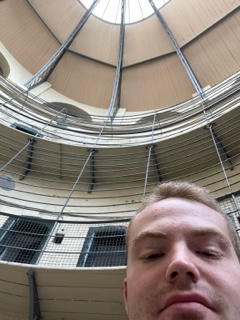Is there any better way to experience the culture of Dublin than to be temporarily in a prison? Well, if so, then I have fully encapsulated the Dublin experience (kind of). Our class visit to the Kilmainham Gaol was an important history lesson that allowed for us as students to understand just how brutal some case studies in English aggression over Irish settlers was in a prison setting. The introductory stories of some of Kilmainham's prisoners were unsettling and heartbreaking. While I forget the name of the three-year-old who was imprisoned for begging on the street, it was almost par for the English course that the three-year-old boy was imprisoned for a roughly two-week period for an action that wouldn't be considered a crime in today's age. The story about Easter Rising revolutionary Joseph Plunkett marrying his beloved fiancé Grace Gifford brought an air of vulnerability to the otherwise bleak, gory prison grounds -- that is, if you were to completely ignore the fact that he was executed for his revolutionary actions by English soldiers a few hours later.

The final minutes of the lives of James Connolly, Joseph Plunkett, and other Irish revolutionaries occurred in this prison yard-like place in Kilmainham Gaol
The Kilmainham Gaol tour guide was not as biased as other tour guides of the liking of Lorcan Collins but was just as passionate about his performance and the history of the jail itself. The Kilmainham had some other interesting rooms as well, such as the office that was converted into what could be considered an upper-class prison cell for Charles S. Parnell, a notable Member of the Irish Parliament, the cells of Countess Markievicz and Eamon de Valera, the beautiful atrium/panopticon noted for its dramatic roof architecture and design style (pictured below), and the prison courtyards that often contained the final moments of resting in the lives of various Irish revolutionaries such as James Connolly and Joseph Plunkett (pictured above).
Part of the atrium/main hall depicting the almost-Hyatt Hotel-like atrium design style that fits under the panopticon style of prison architecture. Also picturing a random, good-looking man??
A day before my temporary stay behind bars at a notorious killing machine of an Irish prison, the most athletic students of UWL hit the pitch (field?) for lessons and games in noted Gaelic Games of hurling, Gaelic football, and handball. Far removed from my athletic peak as an average-at-best high school baseball player, I realized how far my athleticism had faltered in the three years since I was actually involved in competitive sports. I thought the game of hurling to be easily the most difficult to learn as someone who had never even heard of the game, let alone played it. It seemed to combine elements of baseball, field hockey. tennis, soccer, and lacrosse, and to put it lightly, I was clueless on how to effectively play the game, although I'm sure I was not alone in that regard. Moving on to Gaelic football, the objective of the game was like that of soccer -- which I am certainly not fond of -- and I admittedly put the least amount of effort into this game than the other two. However, the transition to handball was the easiest given the fact that I was aware of the game's objectives, and I think I can objectively say I did well in competition. Our lessons in handball were preceding our competition of two-lives handball (double elimination), and while I don't like to toot my own horn -- *makes blaring trumpet sounds* -- I feel like I can pat myself on the back for coming out as champion of two-lives handball. (I had good competition, so I'd like to give credit where credit is due.)
The location of my two-lives handball championship victory!
Subsequent to both my foreign introduction to hurling and Gaelic football as well as my domination of handball, the athletes and I decided to head on over to the Gravedigger's pub for a pint of Guinness. The history of the bar was incredible for how it often acted as a second place of work for the diggers of the next-door cemetery to drown out their dreadful work with Arthur Guinness's finest. The patrons seemed friendly and willing for a conversation, which is emblematic of Irish citizens and Dubliners galore. Later, I was participant of a group of six who crossed off another classic Irish pub off our list: the Boar's Head. I did not partake in downing a Guinness, but two fresh Heinekens was more than enough to quench my thirst whilst chomping down on crispy cod and "chips".
The Boar's Head is a very inviting bar right in the midst of Dublin's city center, in which you can drown out your thoughts in Dutch beer, fish and chips, lively conversation, and Shane Lowry memorabilia.
By the time the second day in Dublin capped off, I acknowledged righteously that Dublin is easily a city that I can fall in love with. While the non-romantic in me is not so quick to fall in love with who and what I encounter, the deep dive into the culture of Dublin granted me a monumental, aggregate sigh of relief for the panic attack I incurred the day I got here. The Kilmainham Gaol connected to class lessons with how Irish revolutionaries being imprisoned can have lasting effects on Irish policy and memoirs, namely that experiences incurred by prisoners can lead to authors' lives being directly or indirectly impacted by the signs of English aggression and/or imprisonment of themselves or loved ones. The Gaelic Games defined how Irish culture and tribalist tendencies can transcend politics and the public domain into athletic events. Alcohol consumption, of which Ireland is known for, helps to explain why some people resort to alcohol to cap off work days, converse with others, or just to enjoy one's time -- which is a solid encapsulation of the Irish experience if you ask me.






Comments
Post a Comment